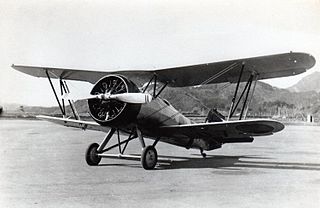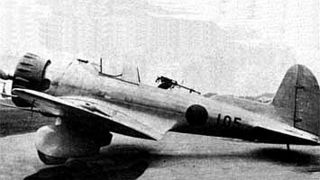 W
WThe Nakajima A4N was a carrier-based fighter used by the Imperial Japanese Navy, and the last biplane designed by Nakajima. The first prototype was completed in 1934, but due to engine trouble the aircraft did not see service until 1936. Given the Nakajima internal designation Nakajima YM, the Japanese Navy designation was Navy Type 95 Carrier Fighter. A total of 221 were built.
 W
WThe Mitsubishi A5M, formal Japanese Navy designation Mitsubishi Navy Type 96 Carrier-based Fighter (九六式艦上戦闘機), experimental Navy designation Mitsubishi Navy Experimental 9-Shi Carrier Fighter, company designation Mitsubishi Ka-14, was a Japanese carrier-based fighter aircraft. It was the world's first low-wing monoplane shipboard fighter to enter service and the predecessor to the famous Mitsubishi A6M "Zero". The Allied reporting name was Claude.
 W
WThe Mitsubishi A6M "Zero" was a long-range fighter aircraft formerly manufactured by Mitsubishi Aircraft Company, a part of Mitsubishi Heavy Industries, and operated by the Imperial Japanese Navy from 1940 to 1945. The A6M was designated as the Mitsubishi Navy Type 0 carrier fighter , or the Mitsubishi A6M Rei-sen. The A6M was usually referred to by its pilots as the Reisen, "0" being the last digit of the imperial year 2600 (1940) when it entered service with the Imperial Navy. The official Allied reporting name was "Zeke", although the name "Zero" was used colloquially by the Allies as well.
 W
WThe Nakajima Ki-8 was an unsuccessful attempt by the Nakajima Aircraft Company to interest the Imperial Japanese Army Air Force in a two-seat modern monoplane fighter.
 W
WThe Kawasaki Ki-10 was the last biplane fighter used by the Imperial Japanese Army, entering service in 1935. Built by Kawasaki Kōkūki Kōgyō K.K. for the Imperial Japanese Army, it saw combat service in Manchukuo and in North China during the early stages of the Second Sino-Japanese War. Its reporting name given by the Allies was "Perry".
 W
WThe Nakajima Ki-11 was an unsuccessful attempt by Nakajima Aircraft Company to meet a 1935 requirement issued by the Japanese government for a modern single-seat monoplane fighter suitable to meet the needs of both the Imperial Japanese Army Air Force and Imperial Japanese Navy Air Service
 W
WThe Mitsubishi Ki-18 was an unsuccessful and unsolicited attempt by Mitsubishi to meet a 1934 requirement issued by the Japanese Army for a modern single-seat monoplane fighter suitable to the needs of the Imperial Japanese Army Air Force. During this competition, Nakajima entered the Nakajima Ki-11, and Kawasaki entered the more maneuverable Kawasaki Ki-10 biplane. The competition was won by Kawasaki, but the new fighter was not accepted by the IJAAF with much enthusiasm.
 W
WThe Nakajima Ki-27 was the main fighter aircraft used by the Imperial Japanese Army Air Force up until 1940. Its Allied nickname was "Nate", although it was called "Abdul" in the "China Burma India" (CBI) theater by many post war sources; Allied Intelligence had reserved that name for the nonexistent Mitsubishi Navy Type 97 fighter, expected to be the successor to the carrier-borne Type 96 with retractable landing gear and an enclosed cockpit.
 W
WThe Kawasaki Ki-28 , World War II Allied reporting name "Bob", was an experimental fighter aircraft designed for the Imperial Japanese Army and meant as a replacement for the Kawasaki Ki-10. It flew in 1936, but was never produced for actual use as the Army chose the Nakajima Ki-27.
 W
WThe Mitsubishi Ki-33 was an experimental monoplane fighter aircraft designed for the Japanese Imperial Army. Two prototypes flew in 1936 but the design never entered production.
 W
WThe Nakajima Ki-43 Hayabusa was a single-engine land-based tactical fighter used by the Imperial Japanese Army Air Force in World War II.
 W
WThe Kawasaki Ki-45 Toryu was a two-seat, twin-engine fighter used by the Imperial Japanese Army in World War II. The army gave it the designation "Type 2 Two-Seat Fighter"; the Allied reporting name was "Nick".
 W
WThe Mitsubishi 1MF10 or Mitsubishi Experimental 7-Shi Carrier Fighter (七試艦上戦闘機) was a prototype Japanese monoplane single-seat carrier-based fighter aircraft of the 1930s. Two were built for the Imperial Japanese Navy, but both were lost in crashes, with no production following.
 W
WIn the late 1930s, Seversky aircraft exported twenty two-seat 2PA-B3 to Japan for operational service by the Imperial Japanese Navy Air Service as the A8V1 Type S Two Seat Fighter. The history of this type in Japanese service is obscure and not covered in any detail in the main English-language references for Japanese aircraft. The aircraft were supposedly imported as a result of Japanese anxiety over escalating losses for their unescorted strategic bombing raids with Type 96 G3M bombers deep into China from bases in Formosa (Taiwan) which had begun in 1937. The purchase contract for the Seversky 2PA-B3, construction numbers 122 through 141 had been negotiated secretly but was to cause controversy in the US and subsequent difficulties in Seversky's relationship with the US government and military. Sources differ on exactly when the aircraft were delivered, but it must have been at least prior to October 1938.
 W
WThe Nakajima Army Type 91 Fighter was a Japanese fighter of the 1930s. It was a single-engine, single-seat parasol monoplane with a fixed, tailwheel undercarriage.
 W
WThe Kawasaki KDA-5 was a Japanese single-seat biplane fighter designed by the German Dr. Richard Vogt for the Imperial Japanese Army.